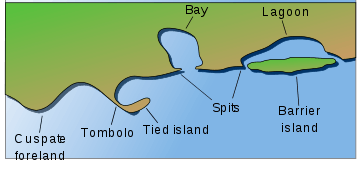Headlands and bays
Both headland and bay are two coastal features that are related and often found on the same coastline. A bay is a body of water—usually seawater (salt water) and sometimes fresh water— mostly surrounded by land, whereas a headland is surrounded by water on three sides. Headlands are characterized by breaking waves, rocky shores, intense erosion and steep sea cliffs. Bays generally have less wave activity and typically have sandy beaches. Headlands and bays form on discordant coastlines, where the land consists of bands of rock of alternating resistance that run perpendicular to the coast.
Geology and geography

Bays form where less resistant rocks, such as sands and clays, are eroded, leaving bands of stronger, or more resistant rocks, such as chalk, limestone, and granite), which form a headland or peninsula. Refraction of waves occurs on headlands concentrating wave energy on them, so many other landforms, such as caves, natural arches, and stacks, form on headlands. Wave energy is directed at right angles to the wave crest, and lines drawn at right angles to the wave crest (orthogonals) represent the direction of energy expenditure. Orthogonals converge on headlands and diverge in bays, which concentrates wave energy on the headlands and dissipates wave energy in the bays.[1]
In the formation of sea cliffs, wave erosion undercuts the slopes at the shoreline, which retreat landward. This increases the shear stress in the cliff-forming material and accelerates mass movement.[1] The debris from these landslides collects at the base of the cliff and is also removed by the waves, usually during storms, when wave energy is greatest. This debris provides sediment, which is transported through longshore current for the nearby bay. Joints in the headlands are eroded back to form caves, which erode further to form arches. These gaps eventually collapse and leave tall stacks at the ends of the headlands. Eventually these too are eroded by the waves.[2]
Wave refraction disperses wave energy through the bay, and along with the sheltering effect of the headlands, this protects bays from storms. This effect means that the waves reaching the shore in a bay are weaker than the waves reaching the headland, and the bay is thus a safer place for water activities like surfing or swimming. Through the deposition of sediment within the bay and the erosion of the headlands, coastlines eventually straighten out. But then the same process starts all over again.
Beach stability
A beach is a dynamic geologic feature that can fluctuate between advancement and retreat of sediment. The natural agents of fluctuation include waves, tides, currents, and winds. Man-made elements such as the interruption of sediment supply, such as a dam, and withdrawal of fluid can also affect beach stabilization.[3] Static equilibrium refers to a beach that is stable and experiences neither littoral drift nor sediment deposition nor erosion.[4] Waves generally diffract around the headland(s) and near the beach when the beach is in a state of static equilibrium. Dynamic equilibrium occurs when the beach sediments are deposited and eroded at approximately equal rates.[4] Beaches that have dynamic equilibrium are usually near a river that supplies sediment and would otherwise erode away without the river supply. Unstable beaches are usually a result of human interaction, such as a breakwater or dammed river.[4] Unstable beaches are reshaped by continual erosion or deposition and will continue to erode or deposit until a state of equilibrium is reached in the bay.
References
- 1 2 Easterbrook, Don (1999). Surface Processes and Landforms (2nd ed.). Prentice Hall.
- ↑ "Erosion and Deposition in Coastal Headlands". 2001. Retrieved 28 January 2016.
- ↑ Schwartz, M. (2005). "Encyclopedia of Coastal Science" . Springer. ISBN 978-1-4020-1903-6 p399
- 1 2 3 Benedet, L.; Klein, A. H. F.; Hsu, J. R.-C. (2004). Practical Insights and Applications of Empirical Bay Shape Equations. International Conference on Coastal Engineering 2004. Lisbon: American Society of Civil Engineers. pp. 2181–2193. doi:10.1142/9789812701916_0175. ISBN 978-981-256-298-2.
External links
| Wikimedia Commons has media related to |

